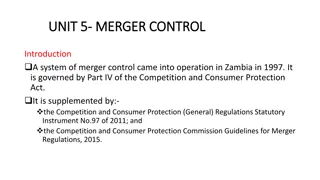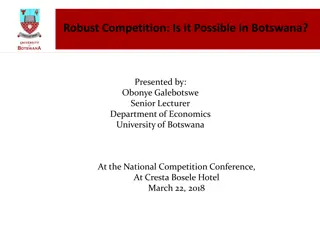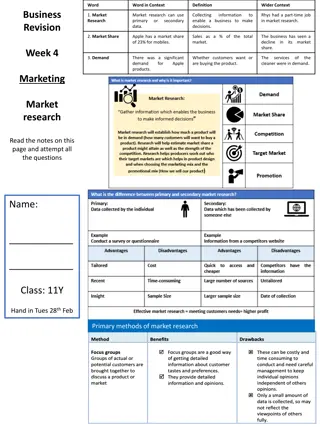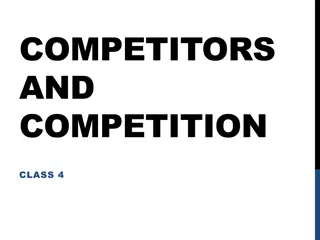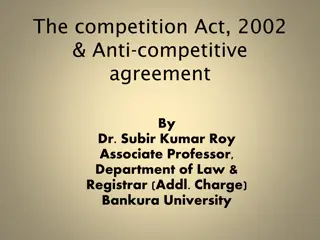Market Structures and Competition Overview
Market structures in economics define the competitive characteristics of different markets. Perfect competition features many small firms producing identical products as price takers. Monopoly has one seller with significant market power, while monopolistic competition involves firms with some market power due to product differentiation. Oligopoly and monopsony also play roles in market structures, each with distinct features influencing pricing and competition.
Download Presentation

Please find below an Image/Link to download the presentation.
The content on the website is provided AS IS for your information and personal use only. It may not be sold, licensed, or shared on other websites without obtaining consent from the author.If you encounter any issues during the download, it is possible that the publisher has removed the file from their server.
You are allowed to download the files provided on this website for personal or commercial use, subject to the condition that they are used lawfully. All files are the property of their respective owners.
The content on the website is provided AS IS for your information and personal use only. It may not be sold, licensed, or shared on other websites without obtaining consent from the author.
E N D
Presentation Transcript
Unit-2 Market Structure Brief highlight of the Unit: Perfect Competition, Price-output Determination under Perfect Competition; Monopoly: Determination of Price Output, Degrees of Monopoly Power, Price discrimination, Multi plant Monopoly, peak-load pricing, Monopoly and Anti Trust Policies, price discrimination-first degree, second degree and third degree, Monopsony, Hidden action & hidden information and monopoly solution. Signaling.
In economics, market structures refer to the organizational and competitive characteristics of markets in which firms operate. The main market structures include:- Perfect Competition: This is the most competitive market structure, characterized by a large number of small firms producing identical or homogeneous products. Firms are price takers, meaning they have no control over the market price and must accept the prevailing price. Entry and exit are easy, and there is perfect information available to both buyers and sellers. Monopoly: In a monopoly market structure, there is only one seller or producer of a product with no close substitutes. As a result, the monopolist has significant market power and can control the market price. Barriers to entry are high, and there is usually no close competition. Monopolistic Competition: Monopolistic competition is characterized by a large number of firms producing differentiated products. Each firm has some degree of market power due to product differentiation, allowing them to have some control over price. Entry and exit are relatively easy, and firms engage in non-price competition, such as advertising and branding, to differentiate their products.
Oligopoly: Oligopoly is a market structure dominated by a small number of large firms that account for a significant share of industry output. These firms have substantial market power and can influence prices and output levels. Entry barriers can be high, and firms often engage in strategic behavior, such as collusion or price leadership. Monopsony: A monopsony market structure is the mirror image of a monopoly, where there is only one buyer or purchaser of a product or service. The monopsonist has significant market power and can exert influence over the prices paid to suppliers or factors of production. Oligopsony: Oligopsony refers to a market structure in which there are only a few buyers or purchasers of a product or service. Similar to oligopoly, firms in an oligopsony have market power and can influence prices paid to suppliers.
Key features of perfect competition include: Homogeneous Products: All firms in a perfectly competitive market produce identical or homogeneous products. Consumers perceive no difference between the products of different firms. Large Number of Buyers and Sellers: There are numerous buyers and sellers in the market, none of whom have significant market power. As a result, no single buyer or seller can influence the market price. Perfect Information: Both buyers and sellers have complete and perfect information about the market, including prices, product quality, and availability. This ensures transparency and efficiency in the allocation of resources. Ease of Entry and Exit: Firms can freely enter or exit the market without facing significant barriers such as legal restrictions, high capital requirements, or exclusive access to resources. Price Takers: Individual firms in a perfectly competitive market are price takers, meaning they accept the market price as given and adjust their quantity supplied accordingly. They have no control over the market price and must sell their products at the prevailing market price. Zero Economic Profit in the Long Run: In the long run, firms in a perfectly competitive market earn zero economic profit, as new firms enter the market attracted by positive profits, increasing competition and driving down prices until profits are driven to zero.







